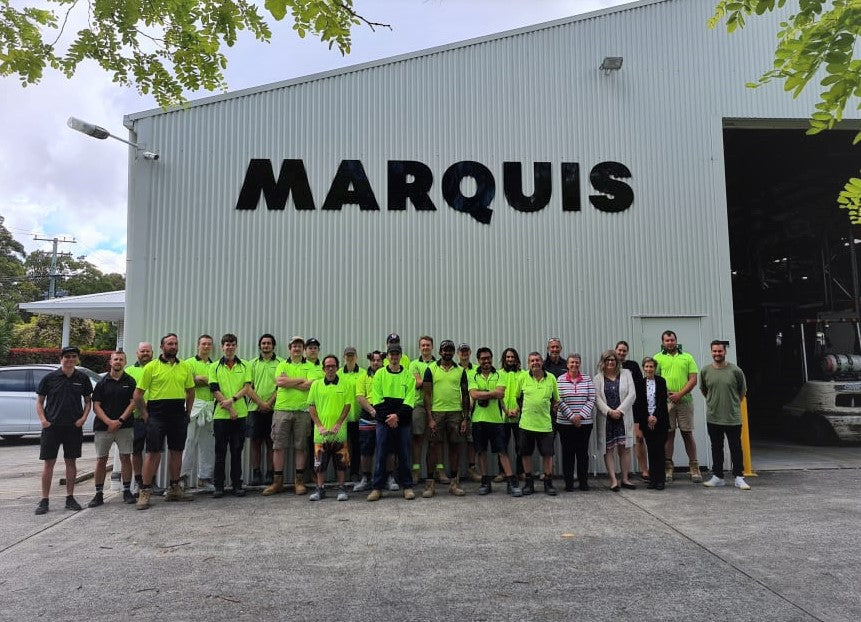When Paul & Jennifer Gray purchased Port Stephens Joinery in 1979, they couldn’t even dream of their businesses’ growth and success 42 years later. Today as director-advisors, they oversee a bathroom vanity powerhouse spanning 120 staff across three manufacturing sites and two sales offices.

The joiner and the teacher
Growing up in Newcastle, Paul commenced a joinery and carpentry apprenticeship whilst working at solid timber window manufacturer. Following his apprenticeship, as a man in his early 20s, he felt the urge to see the world and embarked on a trip of a lifetime. Upon Paul’s return to Australia, he continued his nomadic lifestyle and unofficially moved into his parent’s holiday house, an hour away in Port Stephens.
Back in Newcastle, his future wife Jennifer had completed her education degree and was teaching geography at a local high school.
It wasn’t long after this, the teacher and joiner married and purchased the Port Stephens Joinery and eventually started the renowned Marquis Bathroom Products brand.

Image: The Port Stephens Joinery in Salamander Bay, 1981
It started in the kitchen
Prior to the birth of the Marquis brand, the Port Stephens Joinery produced high end kitchens for the local Hunter region. These kitchens were elegant but simple configurations, produced on beam saws and boring machines with melamine doors. Over the years as trends and technology came and went, from foiled edge to thermo-laminated, solid timbers, veneers and then eventual investment in polyurethane spray equipment. The kitchen manufacturing business was successful, selling direct through showrooms in Port Stephens and the Hunter.

Image: The popular 'Cove' design vanity
Introducing Marquis
After years of producing kitchens, the Gray crew identified an opportunity to manufacture bathroom vanities for the Sydney market, and the Marquis Bathroom Products brand was born. Marquis has been on a mission to make bathrooms beautiful with the highest quality vanities and shaving cabinets. Today the product mix crosses modern and coastal trends whilst still accommodating the classic country look. A collection of vanities was recently featured on Selling Houses Australia.
Design is the centrepiece of all manufacturing, with inspiration heavily drawn from the fashion continent, Europe. Current trends are then adapted and localised to Marquis’ manufacturing capabilities. “We like to use a mix of technology and old fashion craftmanship to create quality pieces for Australia’s best bathrooms”, mentions Allen Gray, General Manager.
As trends generally move in a 20-year cycle, the Marquis team are currently producing vanities with solid timber framed rattan doors and timber veneers.

Image: Paul and Jennifer with their children Allen, Phillip and Allison.
A family affair
Ten years ago, Paul and Jennifer’s children took over the day-to-day management of the business. Although growing up in the joinery since a young age, the children have all lived abroad and had successful careers before returning to Marquis in their respective roles.
Phillip, a trained Geologist, and Allen, a qualified builder, share General Manager duties, with Allison, a radiographer, manages the finance and administration side of the business. Today the three Gray children, all in their 30s, oversee 35 staff in the Marquis division and a further 85 in their stone division (Edstein Creative Stone was acquired in 2012).
The head office is located at Taylor’s Beach, near picturesque Port Stephens in NSW’s Hunter region. This location serves as a combined machining and polyurethane shop with an assembly line. Another site at Soldier’s Point manufactures moulded acrylic vanity tops. A third location, a large stone plant operates from the mid North NSW Coast.

Image: The popular 'Palm' design vanity
The dream team
The five Gray’s have built a very successful operation, however, as Allen puts it “Our team is the key to success. Every single person shares our vision in striving to be the best in bathroom furniture.” A multi-skilled team with a ‘can-do’ attitude and positive receptivity to new technologies and change has seen over 50 apprenticeships completed under the Gray’s tenure.
This team effort has led to Marquis vanities and shaving cabinets being distributed through blue chip retailers such as Harvey Norman, Tradelink and Beaumont Tiles.

Image: An operator uses the Wood Tech NB5X 45° bevel edgebander
Wood Tech & Marquis
One thing the Gray family all agree on is that manufacturing success is dependent on a reliable team and reliable equipment. About five years ago Marquis developed a relationship with Wood Tech, first purchasing a single sided edgebander with pre-milling and corner rounding. Fast forward to 2021 and Marquis have now purchased 3 CNC machines (a mix of Wood Tech and Anderson brands) plus an additional edgebander specifically for 45⁰ bevel edges. The Wood Tech 2812 CNC is currently used as the main solid surface production line, machining 20mm solid surface. It is also used as an overflow machine cutting offcuts, carcass, and melamine doors. The NB5X Bevel Edgebander creates finger pulls on all the decorative melamine doors and is also an additional revenue stream, with Marquis offering the same service to local kitchen suppliers needing their doors bevelled.
Allen Gray states, “Wood Tech create solutions for the Australian market that are cost-effective. They understand manufacturing and are not just selling machines. Even the service team have manufacturing backgrounds and understand the challenges of being a remote factory and the need to keep machines running. Wood Tech just get our business and we will continue to partner with them into the future.”


